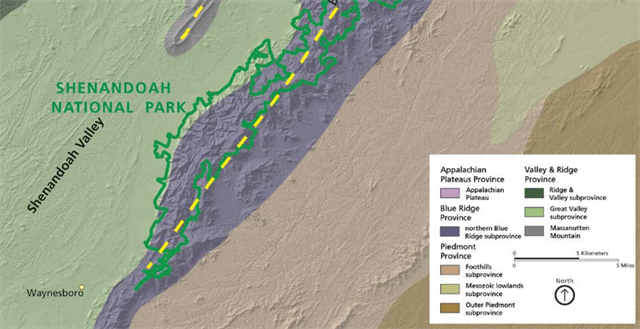
SKYLINE DRIVE
There are countless wonders to behold along your journey.
MAP https://www.nps.gov/shen/planyourvisit/upload/whole_park.pdf
EARTHCACHE REQUIREMENTS
Each cacher must send his/her own answers BEFORE logging a find. Enjoy the journey (learning adventure) as well as the destination (smiley earned). Remember to follow Leave No Trace principles. To get credit for this Earthcache, complete the following tasks:
1. MESSAGE …. What is a physiographic province?
2. MESSAGE …. Which geographic province is straight ahead?
3. MESSAGE …. Describe what you see to the far left. What direction is this and what geographic province is it?
4. MESSAGE …. Describe what you see to the far right. What direction is this and what geographic province is it?
LOG …. Post a picture of you or your signature item at or near the posted coords. This picture is your log signature verifying that you were at the earthcache.
OPTIONAL - Please respect the time and effort involved in creating this earthcache by adding A and B to your log.
A. JOURNEY OF THE MIND ... Science explains what we observe. Relate (in your own words) something you found interesting in the reading. This adds to your learning adventure and your log.
B. JOURNEY OF THE HEART ... Art shares our personal experience of what we see. Share something special you found on site, and why it is special to you. This is a memorable addition to your log and will make other hearts smile.
Journeys of Heart and Mind ...
Stories to Touch the Heart and Puzzles to Challenge the Mind / Rainbow Tree Story
THANK YOU Robert L. Badger for permission to use your book for this earthcache.
THANK YOU Tim Taglauer for permission to place this earthcache along Skyline Drive.
Skyline Drive is a scenic road through Shenandoah National Park in Virginia. The road then changes to the Blue Ridge Parkway with the southern terminus on the boundary between Great Smoky Mountains National Park and the Cherokee Indian Reservation in North Carolina. As you travel Skyline Drive, directions will change several times. Based on what you observed at this overlook, you will be able to easily identify the province.
PHYSIOGRAPHIC PROVINCES
A geographic region with similar characteristics. At this location you can observe the physical differences between the Piedmont, Blue Ridge, Valley and Ridge Provinces. All of the peaks visible from this overlook are "comprised of either the Catoctin Volcanics, the Basement Complex, or the Old Rag Granite."

BLUE RIDGE PROVINCE
These mountains are characterized by high mountain peaks with deep valleys in between. "The Blue Ridge Mountains are noted for having a bluish color when seen from a distance. Trees put the "blue" in Blue Ridge, from the isoprene released into the atmosphere, thereby contributing to the characteristic haze on the mountains and their distinctive color." ... Wikipedia
"The Blue Ridge Mountains began forming during the Silurian Period over 400 million years ago. Approximately 320 mya, North America and Europe collided, pushing up the Blue Ridge. At the time of their emergence, the Blue Ridge were among the highest mountains in the world, and reached heights comparable to the much younger Alps. Today, due to weathering and erosion over hundreds of millions of years, the highest peak in the range, Mount Mitchell in North Carolina, is only 6,684 feet high – still the highest peak east of the Rockies." ... Wikipedia
PIEDMONT PROVINCE
This Province is characterized by gently rolling topography.
"The Piedmont is the remnant of several ancient mountain chains that have since been eroded away. Geologists have identified at least five separate events which have led to sediment deposition, including the Grenville orogeny (the collision of continents that created the supercontinent Rodinia) and the Alleghanian orogeny during the formation of Pangaea. The last major event in the history of the Piedmont was the break-up of Pangaea, when North America and Africa began to separate. Large basins formed from the rifting and were subsequently filled by the sediments shed from the surrounding higher ground. The series of Mesozoic basins is almost entirely located inside the Piedmont region." ... Wikipedia
VALLEY AND RIDGE PHYSIOGRAPHIC PROVINCE
These mountains are characterized by long, even ridges, with long valleys in between.
"These formations are the remnants of an ancient fold-and-thrust belt, west of the mountain core that formed in the Alleghenian orogeny. Here, strata have been folded westward, and forced over massive thrust faults; there is little metamorphism, and no igneous intrusion. The ridges represent the edges of the erosion-resistant strata, and the valleys portray the absence of the more erodible strata. Smaller streams have developed their valleys following the lines of the more easily eroded strata. But a few major rivers, such as the Delaware River, the Susquehanna River, the New River, and the Potomac River, are evidently older than the present mountains, having cut water gaps that are perpendicular to hard strata ridges. The evidence points to a wearing down of the entire region (the original mountains) to a low level with little relief, so that major rivers were flowing in unconsolidated sediments that were unaffected by the underlying rock structure. Then the region was uplifted slowly enough that the rivers were able to maintain their course, cutting through the ridges as they developed." ... Wikipedia

RESOURCES
Geology Along Skyline Drive by Robert L. Badger 2012 edition
Graphics via Internet Public Domain since no contact info available
http://www2.nature.nps.gov/geology/education/osu/BLRI_1999_GIP_Lillie.pdf ... page 22
http://www.nature.nps.gov/geology/inventory/publications/reports/shen_gri_rpt_view.pdf